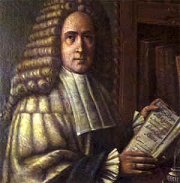 Enjoying "The Seats and Causes of Disease" by G. B. Morgagni
Enjoying "The Seats and Causes of Disease" by G. B. Morgagni
Ed Friedlander, M.D.
scalpel_blade@yahoo.com

The book, of course, is the first detailed record of a lifetime of autopsy practice.
Dr. Morgagni (1682-1771), the government death investigator,
revolutionized medicine.
Unlike Galen and the other medical theorists
who had dominated the field for centuries,
Morgagni has no overarching, terribly-wrong model for disease
to warp his observation. He also shunned
in the "medical controversies" of the day in favor of common sense and
honest uncertainty.
In 1700, an older book ("Sepulchretum", by Theophilus Bonetus)
which abstracted accounts of autopsies from classical authors, was
republished and was very popular despite its being all second-hand and uncritical.
Morgagni decided to make it his
life's work to share his personal autopsy experience with the eager world.
He published his massive series in 1761.
Thanks to his objectivity, Morgagni persuaded the world of
what we now take for granted: the signs and symptoms
of disease depend on where the anatomy is abnormal.
Thanks to Morgagni's work, everyone realized that
cough usually meant disease of the lungs, that jaundice usually meant disease
of the liver, that fluid accumulations were usually the result of local
lesions rather than "imbalances of the humors", etc., etc.
Even though the "why"'s would be discovered much later, Morgagni made
it clear that disease must be understandable.
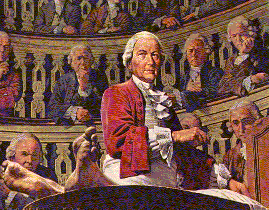 The vignettes in Morgagni's book are engaging, and reflect a real interest
in the lives of his subjects. You'll find that the best pathologists
are like this even today. As he points out in his preface,
he tried to use the simplest language possible.
The vignettes in Morgagni's book are engaging, and reflect a real interest
in the lives of his subjects. You'll find that the best pathologists
are like this even today. As he points out in his preface,
he tried to use the simplest language possible.
Morgagni paid special attention to
the presence or absence of post-mortem clots, especially
in the ventricles of the heart ("polypus concretions").
One issue which was current among physicians of his era
was whether
the blood could solidify during life. Morgagni felt that if this happened,
it must be rare (IV.23). The reason must be that antemortem thrombi look
very different from postmorten thrombi. It remained for Virchow to clarify
the nature, causes and importance of thrombosis -- one of the most critical
concepts in medicine.
Morgagni seldom comments on the size of the heart, even in cases in which
congestve heart failure seems to be the obvious explanation. I suspect that
during his era, when many more people did heavy physical labor
than today, a large heart was nothing unusual.
Morgagni's discussion of the causes of "serous apoplexy" (i.e., ischemic stroke)
attributes this to the edema of the brain. He discusses whether obstruction of
blood vessels could cause stroke, and concludes that it does not, based on experiments in which
his teacher, Dr. Valsalva, ligated and/or embolized the large arteries of animals
without being able to imitate the effects of stroke. This surprising
error must have been caused by
the healthy animals having better collateral circulation. (See IV.2 ff.)
Morgagni argued against the current idea that the pituitary gland serves
to process the spinal fluid.
Morgagni distinguished two types of gallstones based on whether he could ignite them
or not. (We now know these are cholesterol and bilirubin stones.)
He distinguished different kinds of fluid accumulations by evaporating them
and noting how much residue was left (normal
CSF left almost nothing, serous effusions
more, exudates more still, etc.) He also noticed whether there was
coagulation on heating, and whether there was precipitation
in by the familiar "salting out"
technique with ammonium chloride.
As an autopsy pathologist, I am grateful to Morgagni for proving to the world
that disease really can make sense. By looking inside the body and studying
it as it really is,
Morgagni freed medical thought from a great deal of mumbo-jumbo.
And he made it possible for us to make sense of the physical exam,
and to discover the real nature of cancer, infection, and so forth.
As a result, therapeutics became much more rational.
The purpose of this site, which will probably remain under construction for a long time,
is to list what I consider the likely modern diagnosis for each
account in Morgagni's book. Evidently
no pathologist has done this before. Hopefully, an English
translation of Morgagni's text will be online someday soon.
For now, copies should be available in most medical school libraries.
My work is especially
intended for
physicians seeking a classic account of a particular illness
for a presentation. But even a casual reader can get much enjoyment
from browsing in Morgagni's wonderful book.
Ed Friedlander MD
Chairman, Department of Pathology
Kansas City University of Medicine and Bioscience
1750 Independence Avenue
KC MO 64106
816-283-2208
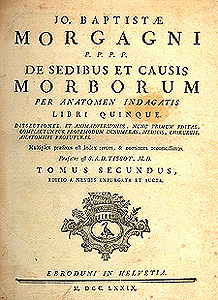 I.2. Bacterial meningitis in a thirteen-year-old boy. He also had TB
in the left upper pulmonary lobe.
I.2. Bacterial meningitis in a thirteen-year-old boy. He also had TB
in the left upper pulmonary lobe.
I.4. Alcoholic cirrhosis, death evidently from an adverse drug reaction producing
headache and pulmonary edema.
I.6. Sheep with a cerebrospinal fluid leak through the ethmoid plate.
Sheep purchased and dissected by Morgagni's teacher, the great Dr. Valsalva.
I.7. Several accounts of brain abscesses.
1.8-9. Morgagni deals with popular claims about worms, bugs, scorpions etc., etc., living
in the brain and causing headache. He attributes these to sleight-of-hand artistry by medical quacks.
I.10. A mentally ill beggar with focal calcification of the dura and a sandy pineal cyst.
I.12. Bacterial meningitis in a nursing mother.
I.14. Anaerobic cerebritis.
I.15-17. A series of other patients with headaches, including some
possible AV malformations, and one of dural metastases. There is a mention of "the case of the beautiful
strumpet", cited by Morgagni without any further explanation
as one with which every medical reader would have
been familiar.
II.9. Cardinal Sanvitus's autopsy. Rupture of an intracranial bleed into
the right lateral ventricle. The prelate's
longstanding "florid face" suggests
hypertension; the illnesses was preceded by vertigo and vomiting over a few weeks.
II.11. Cerebral contusion (or perhaps an intracranial bleed),
with eventual rupture of the hemorrhage into the lateral ventricle.
II.13. Old stroke in the optic radiation causing visual field defect;
second stroke is fatal
II.15. Second bleed into the left ventricle. The patient actually survived a first.
II.17. Posterior berry aneurysm with subarachnoid bleed.
II.18. Subarachnoid bleed with extension into the ventricles.
II.19. Ruptured berry aneurysm at the end of the internal
carotid artery, with obstructive hydrocephalus. Morgagni
found the rupture.
II.22. Subarachnoid hemorrhage.
II.23. Morgagni remembers that his mentor, Valsalva, had a rule
about pathology of the cerebellum, lateralizing the lesion
depending on which way the patient fell. Morgagni cannot remember
the rule and wishes Valsalva had written it down.
III.2. Morbidly obese patient, massive subarachnoid bleed.
An atherosclerotic splenic artery aneurysm is also noted. The famous Dr. Santorini
is co-prosector.
III.4. Subarachnoid hemorrhage.
III.6. Fatal intracerebral hemorrhage. A previous hemorrhage on the other side was also found.
III.8. Morgagni develops the idea that many, perhaps most subarachnoid hemorrhages
result from aneurysms which are obliterated in the process of rupture. He
describes the famous Dr. Ramazzini's prediction that his own death
would result from a berry aneurysm, as it evidently did.
III.11. Fatal subarachnoid hemorrhage.
III.14. A beggar with a fatal intracerebral hemorrhage, with death
being preceded by hemiplegia. Morgagni talks at length about Dr. Valsalva's
discovery that when disease in the cerebrum causes hemiplegia, it is always
on the opposite side.
III.17. Morgagni cites other cases, not his own, including "a monk,
while he was haranguing, was seized with an apoplexy...."
III.18. A blacksmith with a fatal subarachnoid hemorrhage.
He also had a mass of laminated thrombus adjacent to the right
kidney compressing the aorta (i.e., a
fairly recent rupture). Morgagni also describes the autopsy of "the
Danish ambassador", with an intracerebral hemorrhage which ruptured into
a lateral ventricle.
III.20. An elderly man with a subdural hematoma. Curiously, there is much less
history than usual. He also had lipomatosis cordis.
III.24. A fourteen year old boy, already a heavy drinker,
with a fatal subarachnoid bleed.
III.26. Sudden death during sleep in a previously-asymptomatic man with
old rheumatic valvular disease. Morgagni remarked on the extreme congestion
of the cerebral vessels, and hence included it in the chapter on hemorrhagic strokes.
IV.2. A series of stroke cases without hemorrhage begins here.
For most of these, Morgagni reports no specific neuropathology.
He may not have been alert to small lesions in eloquent locations,
and the absence of good refrigeration may have produced enough brain softening
that a fresh antemortem stroke was hard to recognize.
Count Valerio Zani, still remembered as a parton of letters,
had a history of weakness on the right side and eventually developed
a right hemiplegia and aphasia. At autopsy there was some corresponding
cerebral edema. Morgagni suggsted that the count's
sedentary lifestyle and lack of conditioning somehow produced the stroke.
IV.4. Law professor who suddenly collapsed while in church. Diffuse
cerebral edema. Morgagni notes that the lungs were extremely anthracotic ("ink")
-- could the professor have been a heavy smoker?
IV.6. A patient with a fever who developed a hemiplegia before dying. Normal brain autopsy.
IV.7. Another patient with a fever and agonal hemiplegia. Normal brain autopsy.
IV.8. Aphasia during final illness. Normal brain autopsy.
IV.9. Woman recovering from a febrile illness with polyuria, when she suffered
a stroke, developed extensive purpura, and died. Normal brain autopsy.
IV.11. Seventy-year-old man, still very sexually active with a young wife.
Suffered a tremor following mercury poisoning. Died after a stroke;
Morgagni noted only atherosclerosis of the left vertebral artery.
IV.13. A prelate suffered a stroke while riding in a Venetian gondola.
Aphasia and right hemiplagia. Negative brain autopsy.
IV.16. An ostler with stroke before death;
normal brain autopsy.
IV.21. A priest with severe disease of the ascending aorta.
(Morgagni compares it to the surface of a tree but does not describe dilatation.
Was this the treebarking of syphilis without an aneurysm, or was this atherosclerosis?)
Morgagni thought that somehow that aortic lesion caused the clinical stroke.
IV.23. A description by a colleague of organized dural sinus thrombi causing stroke.
IV.24. A fishmonger with a soft-tissue infection on the left cheek, spreading
to the throat. Morgagni says he
would have attributed death to suffocation, except
that it was observed to be sudden death.
IV.26. A farmer with cancer of the ileum, death from clostridial sepsis.
Morgagni describes bubbles in the blood, rigor strong in the jaws and absent
elsewhere, softening of the brain and body tissues, absent postmortem
thrombi.
IV.28. Sudden death in a paraplegic woman. No explanation.
IV.30. A rustic with stasis leg ulcers and chronic constipation; the leg ulcers were healed
by meticulous surgical care. Fecal impaction led to clostridial infection,
with patchy clostridial necrosis of the liver.
IV.36. Eighty year old man with leg ulcers and multiple skin abscesses.
The liver was "white" (elsewhere this refers to capsular fibrosis), the urine "black bile", bubbles noted in the cerebral
vessels. Sepsis?

V.2. Smoker-drinker. Basal meningitis with ventriculitis and abscess in basal ganglia.
V.4. Woman with an infected cancer on her leg; infection after amputation, leading to
sepsis. Left ventriculitis. Morgagni has the idea that infection
travels by the bloodstream, though Valsalva thought this was unlikely.
Morgagni leaves this for future generations to settle.
V.6. Anaerobic lung abscess, with metastatic abscess in left thalamus
V.11. Alcoholic tailor. Pulmonary edema and chronic subdural hematoma.
V.12. Morgagni goes into a discussion of calcification of the pineal gland,
and a calcified pineal tumor the size of an egg.
V.15. Glioblastoma?
V.17. A muscular Ethiopian in Venice, drops dead while playing the trumpet.
Prosectors are Santorini and Morgagni. They find a cerebral air embolus.
V.19. Venetian fisherman dies suddenly in his boat.
Gas embolism resulting from an incarcerated, gangrenous groin
hernia with bowel obstruction. Necrosis of the wall of the bowel evidently
allowed access of gas to the venous system.
V.21. Morgagni describes experimental air emboli in animals.
VI.1. ?
VI.3. Otitis media with meningitis?
VI.6. Encephalitis
VI.8. Bacterial meningitis.
VI.10. Lobar pneumonia with bacterial meningitis.
VI.12. Necrotizing pneumonia with abscess formation,
thrombosis of both superior vena cava and pulmonary vein propagation
into atria (!), superior saggital sinus thrombosis.
VI.14. Pneumonia with meningitis. Man withou normal sexual development.
VII.2. Basal meningitis with hydrocephalus, probably TB
VII.4. Dural sinus thrombosis
VII.6. Delirium; etiology not established from autopsy.
VII.7. Delirium; etiology not established from autopsy.
VII.9. 80 year old man with ulcerative atherosclerosis in the aorta.
VII.11 A potter, noted to be a happy drinking man, jaundice, liver "like marble" (early cirrhosis?),
left empyema, thrombosis of left lateral sinus. The tracheal cartilages were calcified
with bone and marrow.
VII.13. Hemp worker, recently suffered respiratory problems from inhaling dust,
now with necrotizing pneumonia.
VII.15. Old head injury with staining under the dura.
VII.17. Delirium, etiology not established at autopsy. Chiari meshwork,
double ureter, endometrial mass (polyp vs. carcinoma).
VIII.2. Twenty year old woman th mental illness, refused to eat, died of wasting.
Morgagni noted unusually large arachnoid granulations, recognized them as "Pacchioni's glands".
VIII.4. Psychotic man, treated by bloodletting from the temporal artery.
The man removed the bandages afterwards, which so enraged his caretaker
that he beat him and then tied him by the neck to a post, causing him to strangle
to death. Morgagni noted only a choroid plexus cyst.
VIII.6. Butcher "disordered in his sense for four months from the effects,
as was said, of a love potion." Death from hypothermia during the winter.
Morgagni found vesicles along the fornix and base of the pineal, but noted
he had seen this in other cases.
VIII.8. Psychotic woman. Morgagni merely noted the brain was unusually hard.
VIII.9. Psychotic woman, died of an "inflamed breast". Bubbles were found in the
blood (clostridia from an infected cancer?), and extra pigment (meningeal melanin?) around the medulla.
VIII.11. Psychotic man, noted to have "no fluid in the ventricles". (This must have been
a mishap during dissection.)
VIII.12. Psychotic man, noted to have congenital absence of the sternothyroid muscles.
VIII.13. A discussion, based on claims in the Sepulchretum, as to whether
the cerebellar vermis could turn into a real worm. The conventional wisdom
of the day was that it could, at least in horses. Morgagni thought it could not.
Morgagni concludes by saying, obliquely, that he does not believe there
are visible anatomic changes to explain major mental illness.
VIII.15. Psychotic man died of headbanging. No anatomic lesions.
VIII.23. Man with rabies. No brain changes. Gas of decomposition
distended the heart.
VIII.26. On the treatment of rabies.
The current therapy was to throw people with
symptoms of rabies into the water that they dreaded. The dramatic cures
which occasionally followed must have been the people who merely thought
they had rabies, but did not. Morgagni evidently realizes this but is diplomatic.
VIII.27. Man with rabies. No brain lesions.
IX.4. 17 month old child, born hypotonic, now with seizures. No clear pathology.
IX.9. Weedcutter develops dropsy and seizures. Normal brain. Sounds like uremia; there is no account of the kidneys.
IX.12. A cook with urinary tract problems,
renal failure and edema. Chronic pyelonephritis on one side,
the other kidney enlarged to double normal size (hydronephrosis?); pleuritis.
IX.14. A porter with seizures, head-only, no pathology found.
IX.19. Seizures, no anatomic diagnosis.
IX.20. Massive brain abscess.
IX.22. Calcification of the falx. Morgagni recognizes this probably did not lead to any problems.
IX.23 Syphilitic gummas of the face.
XV.6. Fatal asthma in a hemp handler.
XV.8. Infected fibroid with sepsis?
XV.13. Forty year old woman with a clinical diagnosis of "asthma" and loss
of voice; Morgagni and his team found a subglottic laryngeal ulcerating mass with exudate obstructing
the glottis. His demonstration "gave great satisfaction to all present." Mucoepidermoid carcinoma?
XVI.2. New bride with generalized edema, probably nephrotic syndrome. No comment
on the kidneys.
XVI.4. Generalized edema. Etiology unclear. No comment on the kidneys.
XVI.6. Generalized edema, massive pleural effusions. No comment on the kidneys.
XVI.8. Congestive heart failure with hydrothorax.
XVI.10. Congestive heart failure with hydrothorax and ascites.
XVI.12 Woman with organized empyema.
XVI.14. Congestive heart failure with hydrothorax.
XVI.17. Empyema.
XVI.19. Congestive heart failure.
XVI.21. Pericardial effusion.
XVI.26. Massive right hydrothorax with mediastinal shift. Morgagni relates
this to the patient being unable to lie on the left side.
XVI.28. Wool comber with an infected stab wound onver his shoulder blade.
Died of hydrothoraces, but without infection penetrating the chest cavity.
XVI.30. Mesothelioma?
XVI.34. Patient with orthopnea, big pleural and pericardial effusions. Double spleen.
XVI.36. Pleural effusions. Chronic pancreatitis with a dilated duct. Stomach polyp.
XVI.38. Death during pregnancy from pleural and pericardial effusions.
Autopsy was performed at once in order to take the living child for baptism.
Woman had a goiter.
XVI.40. Pericardial effusion under high pressure, i.e., tamponade. Tuberulosis?
XVI.43. Nun with disabling angina. Pericardial effusion at autopsy.
XXVI.9. "A man who had been too much given to the exercise of tennis and the abuse of wine"
died of a sphilitic aortic aneurysm which ruptured through his skin.
At the end, he was nice enough to get a basin so there would be no mess.
XXVI.11. A young man "died suddenly as he was sitting by the fireside
in a house of ill-repute." An aneurysm had ruptured into the right
hemithorax. Morgagni notes the laminated thrombi on the inner surface
and the absence of atherosclerosis.
XXVI.12. Dr. Vater's case of a soldier who was having sex.
"A horrible shout and convulsions of the body" were followed by sudden death.
An aortic dissection had ruptured into the pericardial sac.
XXVI.13. A 28 year old "strumpet" was found dead, her customer having been
seen to leave early looking upset. Morgagni was actually asked to investigate
the case, not as a police matter, but to address the question of whether
semen reaches the oviducts. The lady died of an aortic dissection; Morgagni describes
a careful search for evidence of strangulation, obviously knowing what he was doing.
XXVI.14. A review of women who have died during sex, to address the same
question. Includes mention of people who have died at "wild parties".
XXVII.1. Morgagni describes other people's descriptions of ruptured hearts,
the first by Harvey.
XXVII.2. Ruptured posterior wall in an invalid. Morgagni does not note any associated
myocardial changes, but does comment on calcification of the aortic valve leaflets,
the mitral valve, and its annulus.
XXVII.3. Clostridial sepsis. "Intolerable ill smell"; bubbles throughout the bloodstream.
XXVII.4. Ruptured apex.
XXVII.8. Knight with healing leg ulcers. Ruptured MI. Unlike the other cases,
Morgagni notes there is destruction of the nearby muscle.
XXVII.10. Morgagni mentions the autopsy of a king who died of a ruptured MI; he says
the king's identity will be known to his readers.
XL.2. Priest with arthritis primarily involving the hands,
and kidney sand. Yellow, firm material in the hand joints.
Morgagni mentions the link between gout and kidney stones.
The hand lesions may have been tophi (gout) or pannus (rheumatoid arthritis).
XL.4. An overweight man who died of a urinary tract infection with stones.
XL.12. Acute and chronic pyelonephritis.
XL.24. Old lady with atherosclerosis.
XL.26. A carman with syphilis.
XLI.4. Nephrotic syndrome
XLI.13. Prostatic carcinoma ("like cartilage") and urosepsis.
XLII.2. Syphilitic knight.
More about Morgagni
Eponyms
Catholic Encyclopedia -- Morgagni was both a devout man and one who genuinely did good for those around him -- a great combination.
1911 Encyclopedia
Link is now down.... Rudolf Steiner, founder of the mysticial
"anthroposophy" movement, faults Morgagni in particular for
persuading people to focus on the material rather than
the supernatural causes of disease. Decide for yourself.
| 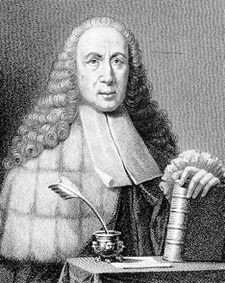 |
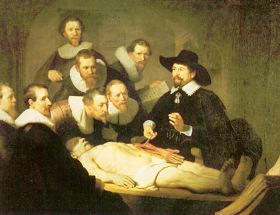 |
More about autopsies |
 The vignettes in Morgagni's book are engaging, and reflect a real interest
in the lives of his subjects. You'll find that the best pathologists
are like this even today. As he points out in his preface,
he tried to use the simplest language possible.
The vignettes in Morgagni's book are engaging, and reflect a real interest
in the lives of his subjects. You'll find that the best pathologists
are like this even today. As he points out in his preface,
he tried to use the simplest language possible.
 Enjoying "The Seats and Causes of Disease" by G. B. Morgagni
Enjoying "The Seats and Causes of Disease" by G. B. Morgagni
 I.2. Bacterial meningitis in a thirteen-year-old boy. He also had TB
in the left upper pulmonary lobe.
I.2. Bacterial meningitis in a thirteen-year-old boy. He also had TB
in the left upper pulmonary lobe.


